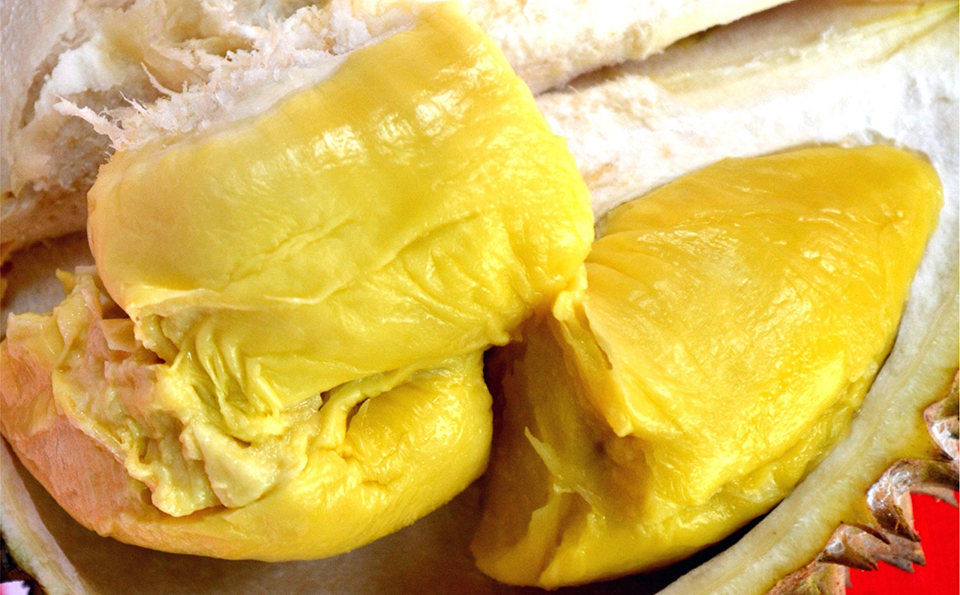Chanel No 5 smells like the breath of a goddess on some people, on others, it smells like week-old work-out sweat. To some, the Durian is the “King of Fruit” – to others – the VAST majority – it is an evil, suppurate egg of decay banned on public transport and in public buildings across Asia.
Looking somewhat like a sea urchin, durian is a unique tropical fruit mainly found in Asian countries. It has been called the “king of fruits” because of its large size (about 1 foot long), weight, and volume of edible flesh. Usually, durian is either loved at first taste or immediately hated. Its fruit is sweet and buttery in texture, with very little juice—it may remind you of a Creamsicle. Durian can be eaten fresh or used to make various types of desserts.
The most unusual thing about the durian is its famously strong smell—so much so it is banned from most public places in Southeast Asia, including hospitals and trains. When travelling, it is always humorous for Westerners to see a “no durian” sign posted beside the “no smoking” sign!
Shopping for Durian
Thailand is the world’s largest exporter of durian, and the fruit is sold in Asian markets or Asian grocery stores here in the U.S. Look for light-coloured spikes without any dark brown patches or bits of white between the spikes, which are signs of over-ripeness. Durian fruit freezes well and is often exported and sold frozen. Store your durian in the refrigerator or a cool place until you can open it.
A durian, also known as the “king of fruits”, is an edible fruit from many tree species that belong to the genus Durio. This seasonal tropical fruit belongs to Southeast Asia and is grown in Malaysia, Thailand, the Philippines and Indonesia.
Notably, the durian fruit has a very pungent odour that can be somewhat off-putting to many. Whereas some people consider its fragrance to be pleasantly sweet, it smells intense and unpleasant for many. In Southeast Asia, fruit is a staple ingredient of many dishes and contains essential nutrients.
The durian is giant in size and has a thorn-covered rind, which makes it different from other fruit species. The shape of durian varies from oblong to round, the colour of the husk from green to brown, and the flesh from pale yellow to red, depending on the variety.
As far as appearance is concerned, the fruit is believed to resemble jackfruit to some extent. Durian fruit is packed with a great amount of sugar, vitamin C, potassium, and the serotoninergic amino acid tryptophan. It is also believed to be a good source of other nutrients like carbohydrates, proteins, and fats.
Origin & Cultural Significance
The word durian originates from the Malay word “duri”, which means thorn, combined with the suffix “an”(used for creating a noun in Malay), meaning a “thorny fruit.”
Durian is believed to have originated in Borneo and Sumatra, with wild trees in the Malay peninsula and orchards often grown in a wide area from India to New Guinea. The fruit has been known to have been cultivated for centuries at the village level in Southeast Asia (possibly since the late 18th century), and commercially it has been grown since the mid-20th century.
Durian is commonly consumed fresh with sweet sticky rice in Thailand. Unripe durians can often be seen prepared as vegetables. But in the Philippines, it is just used to add sweet flavours and not savoury, while in Malaysia, people prepare both sugared and salted preserves using this fruit. Durian mixed with salt, onions, and vinegar is called border.
The seeds of durian (which resemble chestnuts in size) can be consumed after boiling, roasting, or frying them in coconut oil. In Java, the durian seeds can be seen cut thinly and cooked with sugar as a confectionery.
Uncooked durian seeds are considered poisonous due to the presence of cyclopropane fatty acids, so it is recommended to not consume them uncooked. Young leaves and shoots of the fruit are seldom prepared as greens.
Occasionally, the ash from the burned rind is added to some exceptional cakes. In the Batak provinces of Indonesia, the petals of durian flowers are consumed, and people in the Moluccas islands use the husk of the durian fruit as fuel to smoke fish. The nectar and pollen of the durian flower collected by honeybees are regarded as a significant source of honey.
So, are you the person who can’t wear Chanel – or in other words, will Durian be your “King of Fruit” or an extremely pungent reminder of a South East Asian Holiday?

